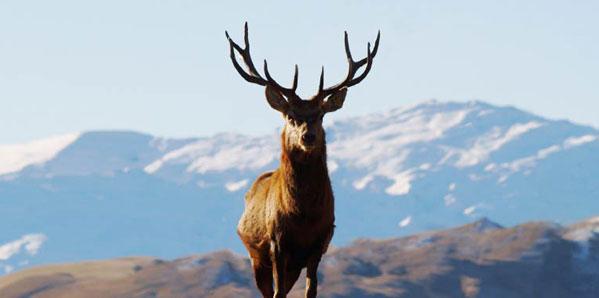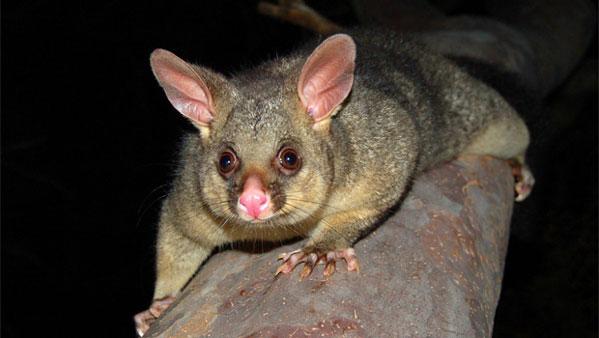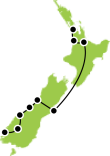
We are often asked what animals can be seen when visiting New Zealand? Well, as we learned in ‘Part 1’ of the series, New Zealand was almost exclusively populated by birds both before and after humans settled.

In this article - New Zealand Animals (Part 2), we look at our present day oceans and the marine mammals that call it home, introduced land-dwelling species and examine some of the more ancient creatures that still call New Zealand home.
In the beginning there were....
- three small bat species (the only terrestrial mammals),
- geckos, skinks, three species of frogs, and the tuatara – an iguana-like animal directly descended from the dinosaurs.
- Freshwater fish were relatively rare, comprising about thirty species, including eels, which became a valuable source of food for Maori.
- native birds as per Part 1.
New Zealand's Marine Animals
Seals, dolphins, and whales abound in New Zealand’s coastal waters. In Kaikoura on the East Coast of the South Island, visitors can see humpback and sperm whales from boats, snorkel amongst bottlenose dolphins, and upon returning to shore, walk through a seal colony, all in the course of a morning. The Hectors dolphin, the world's smallest dolphin, is endemic to New Zealand and is found in the colder waters off the South Island. New Zealand has a reputation as an anglers' paradise; with swiftly flowing rivers teeming with salmon and trout. Over 23 freshwater fish species have been introduced, some very successfully, since the late 19th century by the European settlers.
Introduced Species
Other introduced species include the kiore, a rat which was brought to New Zealand by the first Polynesian settlers. European settlers introduced pigs, goats, sheep, cattle, freshwater fish such as salmon and trout, opossums, rats, rabbits, stoats, and deer. Many of these introduced species, (deer, rabbits, opossums, and goats in particular) adapted so well to the bountiful environment that they rapidly became pests, and have had to be controlled to keep from proliferating.
New Zealand Opossum
Opossums are a major problem as they have bred to a huge population (70 to 100 million) and consume vast quantities of new foliage (approximately 21,000 tonnes per day), killing trees and shrubs, particularly native flora. The department of Conservation put a lot of time and effort keeping these beasties under control.
Chat to our Travel Specialists about adding some nature experiences to your trip - they'll listen to your dream-trip must-do's and build an itinerary that's tailor-made to your desires.
Head over here to view some of our Hiking tours which get you into the country with the most opportunity to experience the wildlife.
For further information Contact us here, or find out more about what we can offer on our website. Written by Brent Narbey You also like to read 'Part 1' New Zealand Birds.
Recent Posts
Blog Categories
Blog archives
- February 2025 (3)
- January 2025 (6)
- December 2024 (12)
- November 2024 (3)
- October 2024 (2)
- July 2024 (2)
- May 2024 (12)
- April 2024 (2)
- March 2024 (2)
- January 2024 (2)
- November 2023 (10)
- October 2023 (4)
- August 2023 (1)
- May 2023 (2)
- April 2023 (2)
- March 2023 (17)
- February 2023 (4)
- January 2023 (4)
- December 2022 (11)
- November 2022 (7)
- October 2022 (1)
- May 2022 (1)
- March 2022 (3)
- February 2022 (3)
- January 2022 (1)
- December 2021 (1)
- August 2021 (1)
- June 2021 (1)
- May 2021 (2)
- February 2021 (1)
- August 2020 (1)
- July 2020 (1)
- May 2020 (1)
- April 2020 (1)
- March 2020 (1)
- January 2020 (1)
- December 2019 (1)
- November 2019 (1)
- October 2019 (1)
- September 2019 (1)
- August 2019 (5)
- July 2019 (2)
- June 2019 (1)
- May 2019 (3)
- April 2019 (1)
- March 2019 (1)
- February 2019 (1)
- January 2019 (1)
- December 2018 (1)
- November 2018 (1)
- September 2018 (1)
- August 2018 (1)
- July 2018 (1)
- June 2018 (1)
- May 2018 (1)
- April 2018 (1)
- March 2018 (1)
- February 2018 (1)
- January 2018 (1)
- December 2017 (1)
- October 2017 (1)
- September 2017 (1)
- August 2017 (1)
- July 2017 (1)
- June 2017 (1)
- May 2017 (1)
- April 2017 (1)
- March 2017 (1)
- February 2017 (1)
- January 2017 (1)
- December 2016 (1)
- November 2016 (1)
- October 2016 (1)
- September 2016 (1)
- August 2016 (1)
- July 2016 (1)
- June 2016 (1)
- May 2016 (1)
- April 2016 (1)
- March 2016 (1)
- February 2016 (1)
- January 2016 (1)
- December 2015 (1)
- November 2015 (1)
- October 2015 (1)
- September 2015 (1)
- August 2015 (1)
- July 2015 (1)
- June 2015 (1)
- May 2015 (1)
- April 2015 (1)
- March 2015 (1)
- February 2015 (1)
- January 2015 (1)
- December 2014 (1)
- November 2014 (1)
- October 2014 (1)
- September 2014 (1)
- July 2014 (1)
- June 2014 (3)
- May 2014 (1)
- April 2014 (1)
- March 2014 (1)
- February 2014 (1)
- January 2014 (1)
- November 2013 (15)
- October 2013 (1)
- September 2013 (1)
- August 2013 (1)
- July 2013 (1)
- May 2013 (1)
- April 2013 (1)
- March 2013 (1)
- February 2013 (1)
- January 2013 (1)
- December 2012 (1)
- November 2012 (2)
- October 2012 (2)
- September 2012 (2)
- August 2012 (2)
- July 2012 (2)
- June 2012 (2)
- May 2012 (2)
- April 2012 (3)
- March 2012 (2)
- February 2012 (2)
- January 2012 (3)
- December 2011 (1)
- November 2011 (1)
- October 2011 (2)
- September 2011 (1)
- August 2011 (1)
- July 2011 (1)
- June 2011 (1)
- May 2011 (1)
- April 2011 (1)
- March 2011 (1)
- February 2011 (1)
- January 2011 (1)
- December 2010 (1)
- November 2010 (1)
- October 2010 (1)
- September 2010 (1)
- August 2010 (1)
- July 2010 (1)
- June 2010 (1)
- May 2010 (1)
- March 2010 (1)
- February 2010 (1)
- January 2010 (1)
- December 2009 (1)
- November 2009 (1)
- October 2009 (1)
- September 2009 (1)
- August 2009 (1)
- July 2009 (1)
- June 2009 (1)
- May 2009 (1)
- April 2009 (1)
- March 2009 (1)
- February 2009 (1)
- January 2009 (1)
- December 2008 (1)
- May 2005 (1)









